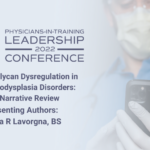Abstract | April 5, 2022
Proteoglycan Dysregulation in Chondrodysplasia Disorders: A Narrative Review
Learning Objectives
- Upon completion of this lecture, learners should be better prepared to identify the rare chondrodysplasia disorder, Schwartz-Jampel Syndrome, and communicate the role of proteoglycan dysregulation in its pathophysiology. Also, audience members should be better prepared to describe the translation of erroneous proteoglycan development in the fetus with specific pathophysiology and clinical symptoms, such as anisospondyly, facial dimorphism, and myotonia. Finally, audience members should identify ⍺-5 integrin and TGFβ receptor pathways as a potential therapeutic target for those with Schwartz-Jampel-Syndrome.
Background/Knowledge Gap: The extracellular matrix (ECM) is composed of proteoglycans and is the non-cellular, structural material surrounding and supporting cells. Perlecan, a heparan sulfate proteoglycan (HSPG) encoded by the HSPG2 gene, exists in the ECM of endothelium basement membranes and is critical in processes such as angiogenesis and cartilaginous and osseous development. Due to perlecan being a critical mediator of such development, we conducted a review of perlecan’s role in chondrodysplasia disorders and potential for therapeutic targeting.
Methods/Design: PubMed Database was searched for relevant articles discussing perlecan and musculoskeletal pathology. Nineteen articles were relevant and included. Results are summarized in the format of a narrative review focusing on perlecan’s impact in chondrodysplasia pathology noted in the literature, including: Dyssegmental Dysplasia Silverman-Handmaker type (DDSH) and Schwartz-Jampel Syndrome (SJS).
Results/Findings: DDSH is an embryonic lethal disorder that causes anisospondyly, micromelia, and encephalocele. Cellularly, it is characterized by a homozygous mutation in the HSPG2 gene that causes absent perlecan formation and subsequent unstable endochondral ossification. SJS, a chondrodysplasia disorder with a milder phenotype, was associated with a heterozygous mutation in the HSPG2 gene, causing reduced perlecan levels. This ultimately results in growth plate disorganization and cartilage degeneration, with symptoms of facial dimorphism, pigeon breast and myotonia that is compatible with life. While complete knockout HSPG2 gene animal models are embryonically lethal, inducible perlecanknockout mice are able to produce phenotypes mimicking chondrodysplasia disorders DDSH and SJS.
Conclusions/Implications: Our findings indicate the perlecan is critical for musculoskeletal development and altered levels result in the pathogenesis of two notable chondrodysplasia disorders. Absent perlecan was associated with the embryonic lethal disorder of DDSH and diminished levels with the milder disorder of SJS. Thus, supplementation of its effect may be beneficial to these pathologies. As Perlecan binds to both the ⍺-5 integrin and TGFβ receptors, targeting of this pathway could yield further therapeutic insight for patients living with SJS.
References and Resources:
- Farach-Carson MC, Warren CR, Harrington DA, Carson DD. Border patrol: insights into the unique role of perlecan/heparan sulfate proteoglycan 2 at cell and tissue borders. Matrix Biol. 2014;34:64-79. doi:10.1016/j.matbio.2013.08.004.
- Gubbiotti, M.A., T. Neill, and R.V. Iozzo, A current view of perlecan in physiology and pathology: A mosaic of functions. Matrix Biol, 2017. 57-58: p. 285-298.
- Martinez, J.R., A. Dhawan, and M.C. Farach-Carson, Modular Proteoglycan Perlecan/HSPG2: Mutations, Phenotypes, and Functions. Genes (Basel), 2018. 9(11).
- Shelley BP, Vinayaka U S. Schwartz–jampel syndrome: Clinical and diagnostic phenotype of a rare genetic disorder. Arch Med Health Sci 2016;4:290-1.

